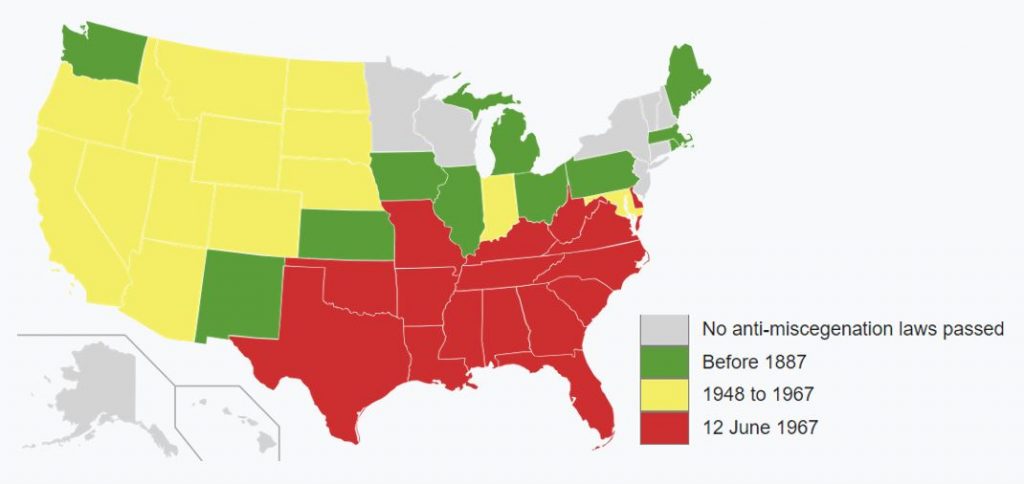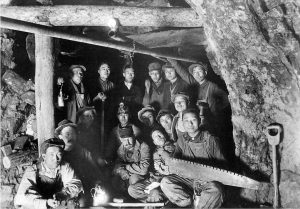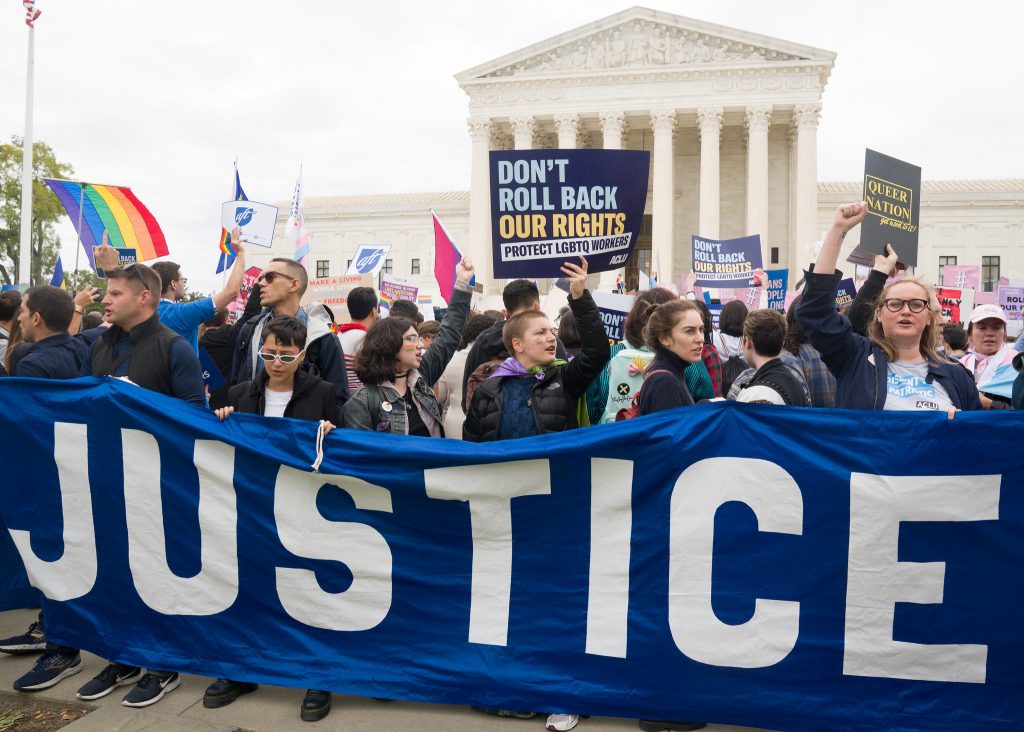The U.S. Government and Families
Elizabeth B. Pearce
One of the most, if not the most, powerful social institutions in the U.S. is the government. It is important to note that in the United States, the federal government has three branches: the Congress, the Executive (President), and the Judicial or Court System. In addition, the Constitution recognizes the rights and responsibilities of state governments; counties and cities have governing structures as well. If you’d like to read more about the development of the Constitution, click here. All of these structures legislate in ways that affect families, some directly and some indirectly. The United States is considered to be a Common Law country, meaning that laws are derived in three ways: legislation created by governing bodies; administrative rules and regulations; and decisions via judicial courts.
Family Composition
Most family law (including marriage, divorce, and adoption) is governed by the states. When there is a great deal of advocacy, unrest, inequity, and/or controversy, family-related matters rise to the federal level. Here are two relatively recent examples:

- In 1958, Mildred Loving, a woman of color, and her White husband, Richard Loving, were sentenced to a year of prison for marrying each other, breaking Virginia’s “Racial Integrity Act of 1924.” The Lovings appealed their conviction in Virginia and eventually to the U.S. Supreme Court, who ruled in 1967 (Loving v. Virginia) that all laws banning interracial marriage were violations of the Fourteenth Amendment of the Constitution. That made it illegal for individual states to restrict interracial marriage. To read a summary of the Supreme Court case, click here.
- More recently, the ruling on Loving v. Virginia has been utilized to argue that laws banning same-sex marriages were also unconstitutional. Between 2012 and 2014, plaintiffs from multiple states filed in state courts to overturn state laws that criminalized same-sex marriages. While several district courts found these laws to be unconstitutional, one district court ruled in favor of the constitutionality of these laws. With the split between courts, the case rose to the level of the U.S. Supreme Court, which ruled in 2015 that all states must perform and recognize marriages between same-sex couples (Obergefell v. Hodges).

Figure 1.19. Dates of repeal of US anti-miscegenation laws by state.
Of note is that while the 1967 decision to legalize interracial marriage was a unanimous decision, the 2015 decision to legalize same-sex marriage was closely contested among the Court members and passed by a narrow 5-4 margin. How would you interpret the differentiated results of these decisions? It appears that there is still disagreement amongst the most powerful in this country about whether the language in the Fourteenth Amendment applies to marriage, gay and lesbian people, or neither. The Amendment states in part: “No state shall make or enforce any law which shall abridge the privileges or immunities of citizens of the United States; nor shall any state deprive any person of life, liberty, or property, without due process of law; nor deny to any person within its jurisdiction the equal protection of the laws.”

From Loving v. Virginia (1967) and Obergefell v. Hodges (2015), we can derive some understanding that governments influence whom we marry, how we divorce, and the legal relationships, rights, benefits, and taxes related to parenting, kinship structures, and children. Critically we must note that the government places value on socially constructed differences such as race, ethnicity, and sexuality in ways that impact individual and family choice.
Laws are only one of the ways that government impacts family composition. Consider the federal government’s role in taxing individuals and families and then providing redistribution of that money via benefits. Benefits such as food stamps, Temporary Aid for Needy Families (TANF), K-12 school lunches, and financial aid for college are all distributed and regulated by the government. Tax credits, such as the Child and Dependent Care Credit, are driven by the government’s definition related to that specific tax. Specifically, the government’s definitions of eligibility and family structure impact who receives benefits and how much they receive. If the government defines “family” or “dependent” in a specific way, does that impact how families form? For example, college financial aid does not count the income of a roommate or domestic partner in an applicant’s income, but it does count the income of a spouse. Might this influence a college student’s decision to marry? While this union is not criminalized as the previous two examples were, it is still impacted by the government’s criteria related to distributing benefits. Some of us might decide to marry or not to marry based on the federal government’s criteria for benefits or taxes.
Family Residence, Kinship Structure, and Equity
While co-residence is considered by many family theorists to be a pillar of the definition of family, it is important to note that not all families live together. In fact, the U.S. government has played a role in separating family members from one another (immigrant and enslaved families in particular).
Sometimes the United States has been idealized as a “melting pot” or even a “salad bowl” of cultures and ethnicities. People often immigrate to this country to make a better life for themselves and their families. The borders of the United States were open up until the late 1800s, when the first restrictive immigration law was enacted: the Page Act of 1875, which excluded Chinese women. This act separated families and was intended to discourage Chinese laborers from staying in the United States.

By 1882, Chinese men were excluded as well. Since that time, there have been numerous restrictive versions of immigration laws in the United States, most of them targeting people from Asian and Latin American countries. Wikipedia provides a list of major immigration laws from 1790 through 2012 here. And in this article in The Atlantic magazine, more recent laws and practices are discussed. In combination with these laws, the United States has continued to rely on immigrant labor to perform less desirable and lower-paying jobs, specifically in agriculture, sanitation, service, and cleaning. There will be more discussion of the effects on these families in the food, employment, and housing chapters. Restrictive immigration laws and policies have contributed to the formation of involuntary transnational families, families whose members live on different continents and/or in different countries.
Another related idealization of the United States originates in the Declaration of Independence, which states, “We hold these truths to be self-evident, that all men are created equal, that they are endowed by their Creator with certain unalienable Rights, that among these are Life, Liberty and the pursuit of Happiness.”[1] It is difficult to defend equality as a fundamental right, both when the document was written and today as well. The most obvious example is the enslavement of people from Africa, who were intentionally imprisoned and brought to this country for that purpose. The Declaration of Independence goes on to describe the institution of governments to secure these rights. But the government specifically secured the rights of life, liberty, and the pursuit of happiness for one group of people (Euro-Americans), enslaved another group (African Americans), and used legal means to oppress Native Americans and immigrants.
Slavery dramatically affected family formations and kinship structures. Because human beings were considered property, their family ties were not respected, which meant that children were habitually separated from parents, adults were not able to marry at will, and common-law spouses were removed from one another at the will of the “owner.” Violence against women in the form of rape resulted in parenting relationships that were structured and controlled by the owners. To understand in more about the treatment of people who were enslaved, read Boundless US History’s chapter about slave treatment, sexual abuses, and publications about maintaining White dominance.
During the writing of the Declaration of Independence and the American Revolution, both free and enslaved African Americans played active roles. About 20% of enslaved people escaped and sought sanctuary amongst Native Americans or the British during the war. Many fought in the war, including Private Lemuel Haynes, who believed that the revolution should also be a war against slavery. He rebutted The Declaration of Independence, saying the document’s principle of freedom should put an end to slavery. Thousands of Black fighters for freedom participated in the emancipation of the United States from Britain.[2]
As Dean Spade writes in the introduction to Normal Life:
Conclusion

In this text we will discuss the ways in which social institutions and processes continue to reinforce the inequities created within the original formation of the United States. We will focus on the federal government and the tension that exists between federal powers and state’s rights, which often leads to inequities amongst American families. We will examine other social institutions such as school systems, health care/insurance structures, the economy, businesses, and places of worship. We will look at the bi-directional nature of people and institutions: the ways that individuals and families organize to create social movements that influence existing practices and structures, and the ways those practices and structures influence people.
By examining the existing structures that limit families, we strive to be a part of the change that will transform our institutions, societal views, and processes in a way that increases and supports equity for all families.
Licenses and Attributions
Open Content, Shared Previously
Figure 1.18. “Robert De Niro and Grace Hightower at the Vanity Fair party for the 2012 Tribeca Film Festival” by David Shankbone. License: CC BY 3.0.
Figure 1.19. “Dates of repeal of US anti-miscegenation laws by state” by Certes. License: CC BY 3.0. Modification: moved key closer to image.
Figure 1.20. Photo by Zackary Drucker as part of Broadly’s Gender Spectrum Collection. License: CC BY-NC-ND 4.0.
Figure 1.21. “Chinese miners Idaho Springs” by Dr. James Underhill. Public domain.
Figure 1.22. “LGBTQ employment rights” by Victoria Pickering. License: CC BY-NC-ND 2.0.
- Jefferson, T., et al. (1776, July 4). The declaration of independence [transcription]. National Archives. https://www.archives.gov/founding-docs/declaration-transcript ↵
- Ortiz, P. (2018). An African American and Latinx history of the United States. Beacon Press. ↵
- Spade, D. (2015). Normal life: Administrative violence, critical trans politics, and the limits of law (Revised and expanded edition). Duke University Press. ↵
Unit of importance that meets the needs of society structured with defined rules and roles.
Legislation and court rulings related to domestic relations such as adoption, union formation and union dissolution.
Lack of fair treatment, opportunity, or conditions.
The Supreme Court decision that legalized interracial marriage in 1967 in the United States.
The Supreme Court decision that legalized same-sex marriage in 2015 in the United States.
An identity that describes someone who is homosexual, i.e. attracted to others of their same gender. Used to refer to men who are attracted to other men, but also used as an umbrella term that includes anyone who is attracted to their own gender.
An identity that typically describes a woman who is attracted to other women.
The social structure that ties people together (whether by blood, marriage, legal processes, or other agreements) and includes family relationships.
A social category and shared identity based on a common culture or national sense of belonging.
A tax credit available to United States taxpayers based on whether they pay for care for a qualifying individual, such as a child or other dependent.
A socially transmitted worldview created, learned and shared by a group which includes values, beliefs, customs and behaviors and which is reflected in language, objects, food, and social institutions.
Families whose members live on different continents and/or in different countries.
Drafted in 1776, the Declaration of Independence announced the separation of the original Thirteen Colonies from British rule and made a statement about the principles that guide United States’ values. Unlike other founding documents, it is not legally binding, although it still has a powerful influence on the American identity.
Everyone having access to what they need.
Spouses whose union has been formed through the process of common-law marriage. Depending on local laws, a common-law marriage is a legally recognized marriage formed without formal recognition, but which meets certain requirements, such as having cohabited for a length of time and presenting as married.
A political and ideological revolution that happened in North America from 1765-1783, causing the American Revolutionary War and resulting in the formation of the United States of America.
Ensuring that people have what they need in order to have a healthy, successful life equal to others. Different from equality in that some may receive more help than others in order to be at the same level of success.

